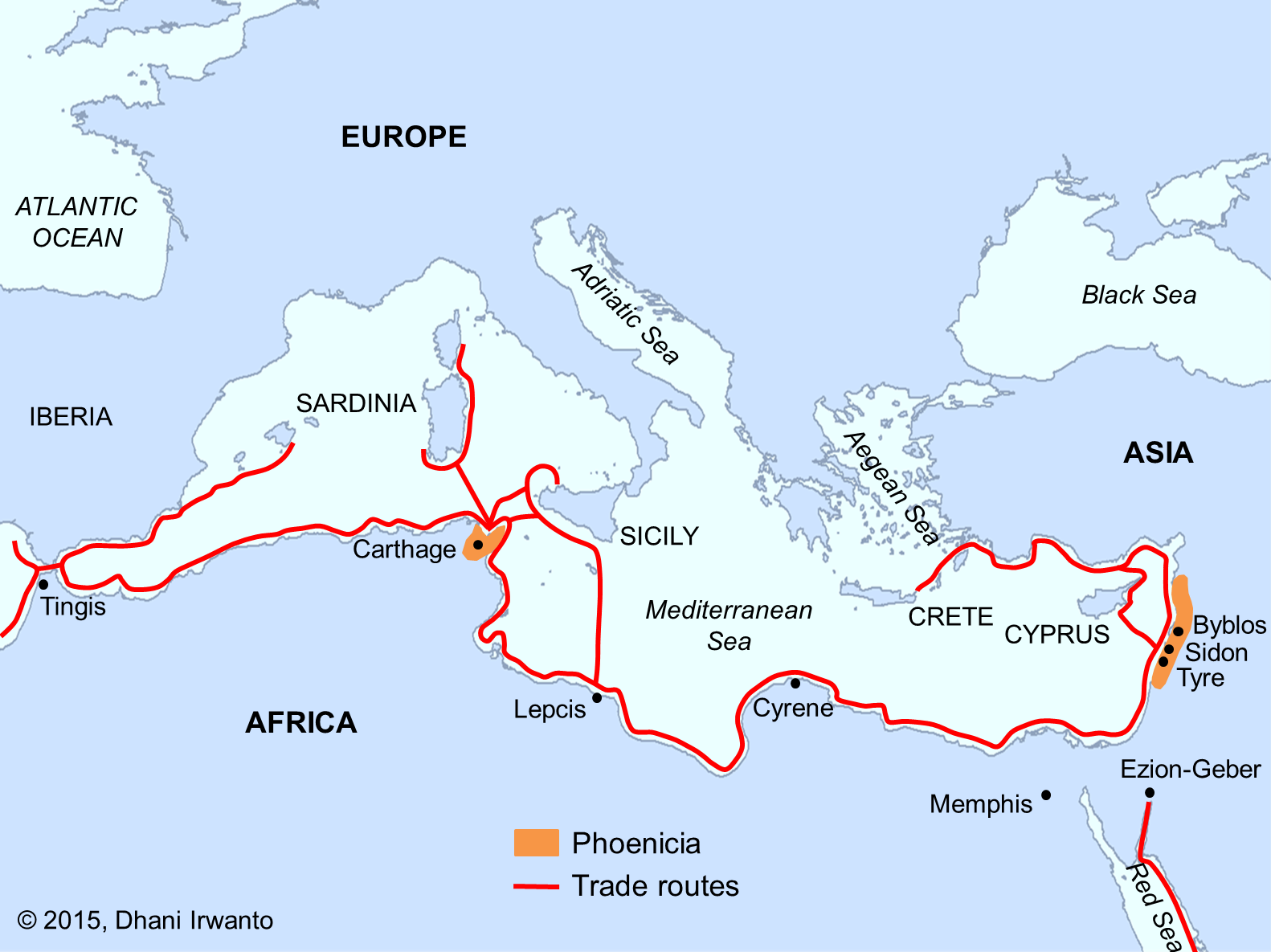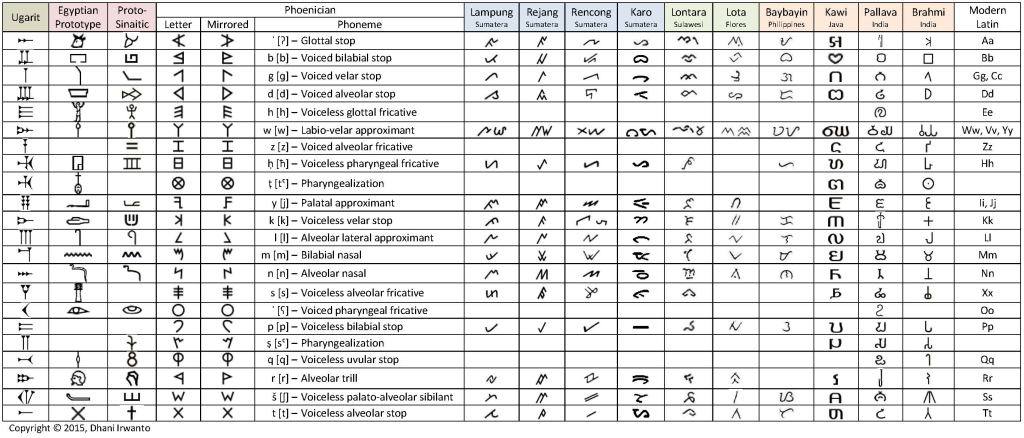A research by Dhani Irwanto
The Phoenicians was an ancient civilization composed of independent city-states which lay along the coast of the Mediterranean Sea stretching through what is now Syria, Lebanon and northern Israel, though some colonies later reached the Western Mediterranean and even the Atlantic and Indian Oceans, the most famous being Carthage. All were fiercely independent, rival cities and, unlike the neighboring inland states, the Phoenicians represented a confederation of maritime traders rather than a defined country. Phoenician city-states began to take form ca 3200 BCE and were firmly established by ca 2750 BCE. Phoenicia thrived as a maritime trader and manufacturing center from ca 1500 – 330 BCE and was highly regarded for their skill in ship-building, glass-making, the production of dyes and an impressive level of skill in the manufacture of luxury and common goods. As Egyptian and Near Eastern documents record, the Late Bronze Age (ca 1600 – 1200 BCE) was a time of economic prosperity for these trading centers. With the decline of Egyptian influence about 1200 BCE, the cities were freed from foreign domination. The ultimate collapse of Egyptian power in the region occurred about 1175 BCE at the hands of the Sea Peoples, of whom the best known are the Philistines. By the late 8th century BCE, the Phoenicians, alongside the Greeks, had founded trading posts around the entire Mediterranean. Sea traders from Phoenicia and Carthage (a Phoenician colony traditionally founded in 814 BCE) even ventured beyond the Strait of Gibraltar as far as Britain in search of tin.

For more than a thousand years, the Phoenicians sailed under different flags in the Mediterranean, the Atlantic, the Red Sea and the Indian Ocean. The first recorded appearance of the Phoenicians in the Indian Ocean is connected with the establishment of the port of Ezion-Geber in 950 BCE. It is also possible for them to sail by their own trading expeditions since they knew about the benefits of sailing to the Far East. There is no doubt they were capable of crossing vast oceans using currents and winds.
The Phoenicians were famed in Classical Greece and Rome as “traders in purple”, referring to their monopoly on the precious purple dye of the murex snail, used, among other things, for royal clothing, and for the spread of their alphabet. The trade of precious commodity also involved precious gems, where rubies and diamonds were first cut and polished in India (Greater India, including Southeast Asia). The most credible scholars knew that the Phoenicians were very secretive with the sources of their trading empire. The source of the materials and the recipe for the preparation of the dye solution are still in mystery.
The main natural resources of the Phoenician cities in the eastern Mediterranean were the prized cedars of Lebanon. Phoenician artisans were skilled in wood, ivory, and metalworking, as well as textile production. The Phoenicians used the cedar of Lebanon for building commercial and military ships, as well as houses, palaces and temples. There is no evidence of ancient cedar forests in Lebanon; the current cedar trees could very well have been transplanted from elsewhere during ancient times. Other than that, the stories of tin credibly involve the Phoenician. The mystery still remains as to where the Phoenicians truly arose from, certainly not from the Mediterranean region because there is no story about it. There is no history of Indian sailors trading on the open seas; for they were better known as brokers or middlemen for the sake of logistics. The secretive of the Phoenicians makes unanswered question from where the Phoenicians arose.
The oldest attested form of the name Phoenicia is the Mycenaean po-ni-ki-jo. Po-ni-ki, ultimately borrowed from Ancient Egyptian fnḫw (fenkhu) meaning “Asiatics, Semites”. Herodotus’ account (written ca 440 BCE) refers to the myths of Io and Europa (History, I:1):
“According to the Persians best informed in history, the Phoenicians began the quarrel. These people, who had formerly dwelt on the shores of the Erythraean Sea, having migrated to the Mediterranean and settled in the parts which they now inhabit, began at once, they say, to adventure on long voyages, freighting their vessels with the wares of Egypt and Assyria …”
The Indian Ocean was formerly named the Erythraean Sea (Herodotus, Dicaearchus, Eratosthenes, Posidonius and Strabo), where the Phoenicians formerly dwelt and need long voyages to migrate to the Mediterranean. Implicit in this account is that the Phoenicians were originated from the “East” or “Asiatic” at the shore of the Indian Ocean.
Velikovsky (2006) relates the name Phoenicia to pontifex, which means “high priest”. The word “pontiff” is not of Latin origin. It is not derived from “pons”, but probably from “Punt”. When it is said that Hatshepsut, after visiting Punt, built a “punt” for the god Amon, this means a sacred place of worship. By erecting a “punt” in Egypt, Hatshepsut also introduced the institution of the high priest, copying the service of the temple in Jerusalem, built on a Phoenician model.
Solomon’s alliance with Hiram, the king of the Phoenicians, explains the strong Phoenician influence in the life of the kingdoms of Judah and Israel. This influence is stressed in the scriptures in the story of the erection of the temple, built with the help of Hiram, who provided Solomon with building material and with the chief craftsman, a man of Hebrew-Phoenician origin (I Kings 7:13-14). Also the common expedition to Ophir and the peaceful transfer of territory from the domain of one king to that of the other (I Kings 9:11) might have brought it about that the whole of Palestine at that time was called Phoenicia. It is very likely that the Egyptian expeditions to the Land of Punt at the later period were also by the help of the Phoenicians.
Perhaps the most significant contribution of the Phoenicians was an alphabetic writing system that became the root of the Western alphabets. Linguistic and alphabet studies of the Rejangese culture conducted by among others Sir Thomas Stamford Raffles (1817), J Park Harrison (1896), EEEG Schroder (1927) and MA Jaspen (1983) show some correlations to the ancient Phoenician and Egyptian. The author makes comparisons among the three main groups of the southern Sumateran scripts: Rencong (or Ancung) in Kerinci, Rejang in Bengkulu and Lampung in southern Sumatera, and the Proto-Egyptian and Proto-Sinaitic (Old Phoenician) as shown in Table 1 (Irwanto 2015). Also shown the Brahmin-influenced scripts, Ugarit and the modern Latin.

As we can see from the comparison, the Lampung, Rejang and Rencong closely resemble the Phoenician’s Proto-Sinaitic rather than the Indian’s Brahmi. These three regions of Sumatera were very little influenced by Indian culture in the past. The Phoenician alphabet was derived from Egyptian hieroglyphics and became one of the most widely used writing systems, spread by Phoenician merchants across the Mediterranean world, where it evolved and was assimilated by many other cultures.
Jones-Gregorio in 1994 made a study for his thesis about Egyptian and West Semitic words in the Rejangese culture base on Jaspen’s Rejang dictionary. He concludes that many of the Rejangese words seem to be unquestionably ancient Egyptian and Phoenician.
From the genetic studies, most of the descendant lineages of haplogroup K2, also known as K-M526, are located today in Southeast Asia and Oceania (Karafet et al 2014). Ancient members of haplogroup K2, M70, dispersed across the Mediterranean world. They traveled west along the coast of North Africa and also along Mediterranean coastline of southern Europe. These movements suggest an intriguing possibility that the M70 marker may have been carried by the Phoenicians (Spencer Wells 2007).
The origins of the Egyptians as well as the Phoenicians are probably the Land of Punt, viz Sumatera. We could speculate that the Egyptians were the earlier Puntites and the Phoenicians the later. During the Late Period much of Egyptian trade was in the hands of the Phoenicians and Greeks. A long history of contacts with the Egyptians made the Puntites (or the Sumaterans) learned from the Egyptians how to voyage and to trade luxurious goods of their products. It is natural that the producers always keen to sell their products directly to the costumers to gain their own profit. They allegedly had a cooperation with the Buginese in Sulawesi to build the ship. Buginese traders were frequently visited Bengkulu and Enggano Island in the ancient times for the trading of supreme quality coconuts (Helfrich 1891). The Rejangese alphabet is also related to the Buginese. The Buginese has the pinisi ship – phonetically in close resemblance with the name “Phoenicia” – which has been proven tough to sail the vast oceans.
The abundance of wood with high quality in Sumatera could probably facilitate them to build more sophisticated ships than those of the Egyptians. The source of goods to trade, ie murex snail, incense, precious gems and cedar wood among others are typical of the Southeast Asian origins. Perhaps, these Puntites who had managed to do this trade were then called the Phoenicians, from the roots “Punt”, “Pwene” or “pinisi”. To have the monopoly of the Asian traded goods in the Mediterranean, the Phoenicians kept the secrecy of the sources until in the 18th century the Dutch and the British managed to explore the resources in great amount. The Indian Ocean coastal people of Sumatera as well as the Buginese are renowned for their proficiency in trade. Their legends and songs also tell stories about oversea trading (merantau, “to wander about”). The Buginese along with the Barito Dayak in Kalimantan are traced to have relationships to the Malagasy in the antiquity.
Also, a long history of contacts with the Egyptians made the Puntites learn hieroglyphic writing, but then developed it further to become an alphabetic script. The Lampung, Rejang, Rencong and Bugis alphabets are the legacies of this script as has been discussed above.
***
2 thoughts on “The Phoenicians”